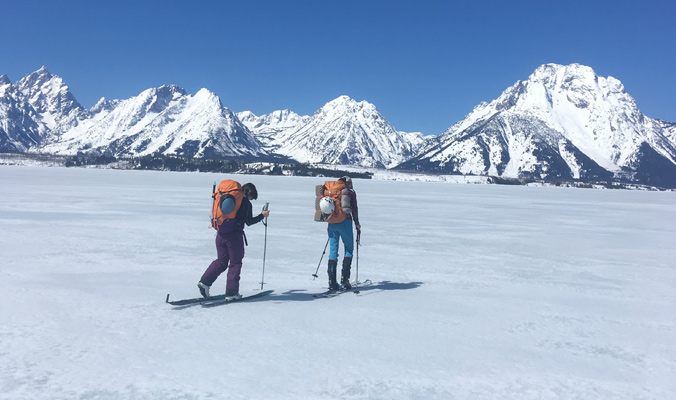Wyoming’s Grand Teton National Park (GTNP) is known for its steep, rugged backcountry ski terrain dotted with 50-degree chutes and exposed faces, all within a five-mile skintrack of the Bradley-Taggert Parking Lot. But while tourers can approach the park’s peaks with relative ease, a hidden barrier to access exists: the absence of weather reports from winter weather stations in GTNP. This deficit is one that some Jackson Hole locals are currently working to rectify through the construction of new stations within park boundaries.
“All of our telemetry is coming from Rendezvous Peak,” says Adam Fabrikant, an American Avalanche Institute instructor and Exum ski and mountain guide. “When I was forecasting for guides to go out for Mount Moran, objectives in the northern part of the park, or even just central higher peaks around Garnet Canyon, I felt as if we were lacking some close-to-home information.”
So in 2016, Fabrikant started writing an in-house forecast for Exum Mountain Guides to try to address the observation gap for the Park. Despite his efforts, he found it challenging to forecast for northern areas of the park when the closest weather station is 20 miles away, based at Jackson Hole Mountain Resort and Teton Pass.

Rachel Reich and Kate Carothers ski across Jackson Lake to Mount Moran in Grand Teton National Park. [Photo] Betsy Manero
“I’m not going to take credit for making this [project] happen,” says Fabrikant of his roll in pushing for the new development. “Both the Park Service and the Forest Service worked together in an interagency operation. I am simply just an involved skier.”
To begin this process, Fabrikant submitted a proposal to the Grand Teton National Park Foundation—a non-profit that supports park initiatives that exist outside of federal budget allowances—asking for the funds to help build the stations.
In response, the Grand Teton National Park Foundation agreed to kick start a $25,000 fundraising initiative to purchase and install structures in two locations—a goal they hit this Saturday, August 18 thanks in part to the Steve Romeo Memorial Fund. The Foundation then worked closely with the GTNP and the Bridger-Teton Avalanche Center’s Director, Bob Comey, to find appropriate places for the stations.
The location scouting is paramount, as each will hold a specific purpose. The Steamboat Mountain station, which sits at around 7,800 feet in elevation, will measure snowfall. “We think it’s a pretty good snowfall site,” says Comey. “We think that it’s going to provide good information to us as forecasters about what’s going on in the northern part of the park.”
The 25 Short location is still being surveyed, but will report winds for the park. Comey is also hoping to put in a community-sourced snow depth station in One Hour Meadow at the base of 25 Short. “We’ll probably put a total depth stake there and a manual storm board pretty close to the upskin track,” Comey explains. “We’ll have [guides] from the different guiding services, the rangers and ourselves stopping by the station frequently and taking actual field measurements from the storm board and communicating that to the avalanche center.”

Red dots mark the Steamboat Mountain Station and the two proposed 25 Short locations within the GTNP.
For six-year splitboarding veteran of GTNP, Rachel Reich, adding these new stations would help provide more information that could up her margin of safety in the backcountry. Reich spends 50-plus days a year touring in the park and has to rely on self-forecasting and gathering information from fellow skiers. Like Fabrikant, she currently struggles to get accurate snow and weather data and often finds different conditions than expected in the park. “The more information we can have [access to] is helpful in keeping us and our team safe,” says Reich. “I’m happy that we’re expanding that.”
While Reich has learned to self-forecast for the area over the past six years, many newer backcountry skiers have not had the same experience. According to local AIARE Instructor Patrick Wright, these stations will be helpful for all users, including his students.
“It will provide a potential learning opportunity for Avy courses using the GTNP venues, where students can look at weather data directly from the planned tour zone and maybe even check out a weather station or snow study plot during the tour,” Wright notes. The data coming from these new stations will be available this upcoming season on the Bridger-Teton Avalanche Center’s website.
Fabrikant is also optimistic about how these new stations could help both his guiding and personal skiing. “When we go into winter, which is our really dynamic time of year, the weather is much more challenging to predict,” Fabrikant reflects. “When localized snowfalls are quite different from canyon to canyon, I think it will make us all better at our jobs, whether it’s finding the good, soft snow or just avoiding the avalanche hazard or problem for the day.”
—
Click here to learn more about the Grand Teton National Park Foundation and their weather stations initiative and here to learn more about the Bridger-Teton Avalanche Center and help support the current forecast.










Related posts: